However, the report goes on to state that a DF&G study in 1968 by Miller and Odemar had almost the opposite results: Santa Cruz was the best fishing pier (1.25 fph) and Monterey Wharf #2 was one of the poorest (.50 fph).
The contradictory results reflect the nature of Central Coast piers that can have a very high or poor catch rate dependent upon the arrival of certain schooling species—sardines, jack mackerel, Pacific mackerel, jacksmelt, walleye surfperch, shinerperch, bocaccio (nobody knows for sure if these baby rockfish will ever reappear in their once substantial numbers.), and increasingly, lizardfish The DF&G results by the way differ substantially from my personal results (1975-2014): Monterey Wharf #2 (12.2 fph), Santa Cruz Wharf (8.33 fph).
<*}}}}}}}}}>< — Poaching is something that goes on at piers and especially at piers that see as much use at Wharf #2. A natural question that arises is when poachers should be confronted—and how. The following was sent in by one of my friends, James Liu. James was a longtime member of the United Pier and Shore Anglers Board, an excellent fisherman, a Boy Scout leader, an intellectual giant (two PHD’s in nuclear physics), and one of the finest men I have ever known. James was a large man with a large heart and was not hesitant to confront poachers. James was born in Taiwan and he especially objected to poachers who were Asian because, as he once explained to me, he had personally had to face discrimination so many times growing up due to the poor actions of others. He hated the perception by many that all Asians break the angling rules and he tried to teach as many people as possible the proper and legal ways to fish.
My first exposure to his “power of persuasion” occurred one night when we were fishing at the Green Pleasure Pier in Avalon and two young (Asian) men were illegally hooking and keeping lobsters. Other people tried to get them to stop with little success while James got them to stop and got them to return the lobsters to the water. How? By explaining to them how their actions made him look bad. James was a person who was always willing to walk the walk as well as talk the talk. James died in 2013 and will always be sorely missed.
Date: August 2, 2003; To: PFIC Message Board; From: gyozadude; Subject: Monterey Municipal Wharf — Poacher’s Tale
I found myself groggy, but awake at 5am this morning trying to finish some work, only I was in Monterey, staying not far from the Wharf. So I got off some email and headed out for a short walk at 6am this morning. I thought I’d try to catch the slack low tide in the early morning.
Well, I tossed a chromed Buzz Bomb with a single shank barbless hook for about an hour off the east side of the pier and hiked up and down. A few regulars there cussin’ to themselves or using it to pick up some down-n-out ladies hanging out in their beater cars on the wharf.
Passed by a bunch of Vietnamese fishermen with 9-ft Ugly Stiks fishing Sabikis without much luck near mid-pier. More hung back in their minivans, smoking and watching for any signs of fish. I asked the guys standing outside if they were seeing any runs. No, one guy responded with a smile. But they were watching for anyone, smiling at me. One guy commented that it had been dead for the last few days. No bait, no big fish. The guy cussin’ profanity every sentence said he’d, “What da f—sh–yu tellin’ ‘im? I seen 3 already right here… F—!”
They gave my gear the once over and took notice of the chromed Buzz Bomb, but didn’t say anything.
I walked on toward the end of the pier and fished close to the zone that had a sign that read, “No Fishing Beyond This Line.”
I passed by a middle-aged Filipino man fishing pile worms on a hi-lo, and saw two Vietnamese guys fishing, one of them on the other side of the line in a “No Fish” zone. A younger guy, a mixed Caucasian/Asian guy, around 20-something and maybe just short of 6 ft tall was fishing the west side of the wharf.
Nothing but seals and sea lions, and weeds for the hour I tossed.
Finally, the Filipino man hauls up a 5” rockfish. The young guy and I walk over and see what it is. From a distance I already suspected it was a small bocaccio. It was throat hooked. The old Filipino man complains that it’s throat hooked. The younger guy offers his multi-tool (Leatherman style tool) for the hook extraction.
I commented to the Filipino, “Sir, that’s a bocaccio, and currently restricted. No bocaccio can be kept. Since it’s throat hooked, the standard procedure is to cut the leader as close to the hook as possible and release the fish.”
The young guy looks at me and asks, “how do you know it’s a bo-ka- what?”
“BO-ka-CHEE-O,” I emphasized. “See, the brownish tint, large mouth lip plate that extends back behind the eye, and the prominent lateral line that is curved up and back. Bocaccio are one of four rockfish closed to all take by Fish and Game regulations section 26.85.”
I walked away from the two and went back to tossing my lure around. A Young kid walked to the end of the pier and was asking anyone if they caught anything. He stopped for a while to observe the two guys doing the hook extraction. They hadn’t listened to me. They still took the hook out. And at that point, the older Filipino man bagged the bocaccio.
So back I went toward the man, and I pulled out my dig-cam and snapped a shot of the guy. He had that puzzled look on him.
In clearly stated terms, I spoke to him, “Sir, Fish and Game regulations prohibit the take of Bocaccio. I told you that before, and you knowingly broke the law.”
“What law?!?” he demanded vehemently. “I, I throw it back, okay?”
I said to him, “Section 27.82 of the regulations define rockfish closures and, Sir, section 1.87 prohibits the waste of fish. You may throw the fish back, but it was gut-hooked and now, its chance of survival is quite low since you ripped its guts out extracting your hook.”
The young kid started to pay some interest, as we were getting a little loud.
“What are you going to do with the picture?” he demands in a threatening tone.
“Oh, the picture? I’m going to send it to DFG.” I tell him.
“You violated my privacy… you can’t do that. I didn’t know the law! … Hey, where you live? I find your address… and you watch out! This is Bullsh–!!! You are full of bullsh–. I know no laws. You violate my privacy… I’ll get your license plate…” he threatens.
So I stepped up to him and clearly asked him. “Sir, is that a threat? Are YOU THREATENING ME?”
He was fuming at this point and I had my hands in my pockets on my cell phone. But he didn’t know that. “Uh… no… but you have no right to take my picture.”
“Sir, you’re standing on public property in the open. Anyone can take your picture…” I explained.
“You bullsh–… and stop calling me sir… go ahead call the cops. I take your picture TOO! You’re in violation. You bullshit too. You in violation. I don’t know the law…,” he yelled at me… (and I’ve paraphrased some statement which would be inappropriate for this forum.”
“Well, sir, ignorance of the law is no excuse,” I told him.
After a minute of his nagging, I walked away and back toward the foot of the pier to head back to the hotel. He shouted at me as I walked away, “You think you smart? You da one ignorance. You bullsh–!!! You da ignorance… I find your address.”
Anyway, I walked back down with the young boy who was asking me about more details. His dad had a boat and he was waiting to head out with him fishing, but they weren’t ready yet. We stopped about mid way and I called 1-888-DFG-CALTIP. Wow! A human answered, and I filled out a report. Didn’t think they would scramble any units, but I did my duty.
The young man asked why bocaccio were closed and I explained that they’re closed so stocks can rebuild for fishing, so folks like my kids, and him can grow up and still have bocaccio to catch. Then it was his turn to look puzzled. Well, why did that guy have to steal fish? I just love it when kids can figure out that poaching is wrong!
Epilogue: The poacher took off in a hurry. Paul Gaske from DFG enforcement called me and we talked for quite sometime, and he might show up on this website. I told him about some UPSAC activities and we’re hoping to have another person involved in our education efforts! Not all skunked this morning.
P.S. Picture of poacher to be posted later when I get the USB cable for my camera or the adapter/reader (both of which I left at home)
Addendum: (In reply to: Re: Monterey Municipal Wharf — Poacher’s Tale posted by urge2fish on Aug-2-03 11:04am)
I wasn’t quite alone. I had a young boy who was a witness. Also the young mixed Asian/Caucasian angler in his early 20’s who initially offered his Leatherman-style tool to do the hook extraction. He distanced himself pretty quick from the poacher when he realized that he may have helped some poacher keep and illegal fish and I was going to call it in.
At night somewhere in East Palo Alto? Heck no. No bein’ a hero for me. But in Monterey? With lots of tourists, hikers, and folks already on the beach and pier at 7am? Yeah, I think it’s viable. Every situation is different. And it was a judgment call. But look at the pic. Was it worth it? Heck yeah.
Reminds me of a credit card commercial. A cheap department store combo: $60. Terminal tackle: $2. Pile worms: $4. Getting ratted out by a big Chinaman who knows the regs: $790. Getting caught on dig-cam as a poacher and having it posted to the net: $Priceless.
<*}}}}}}}}}>< — This wharf as well as the adjoining wharf—Fisherman’s Wharf—has appeared in many movies. Those specific to Wharf #2 include Captains Courageous shot in 1937. Scenes included two schooners tied up to Wharf #2. They Drive by Night was filmed in 1940. Several other movies were filmed in the harbor and at Fisherman’s Wharf and may contain scenes or shots of Wharf #2; they include A Woman of the Sea/The Sea Gull (1926); Tiger Shark (1932); I Cover the Waterfront (1933); Mutiny on the Bounty (1935); Captain January (1936): Edge of Darkness (1943); In Love and War (1958); and The Candidate (1972). Some sources say that See America First (1915) includes shots of sea gulls at Wharf #2 but considering the fact that Wharf #2 wasn’t built until 1926 that idea seems just a tad bit unreasonable, even if it is the movies. Maybe Fisherman’s Wharf?
<*}}}}}}}}}>< — Fisherman’s Wharf sits just across the parking lot from Wharf #2 and is a must visit spot for most visitors to Monterey. It is slammed at times for its tourist glitz but I’ve always enjoyed a stroll on the wharf and have had many a fine meal at its restaurants.
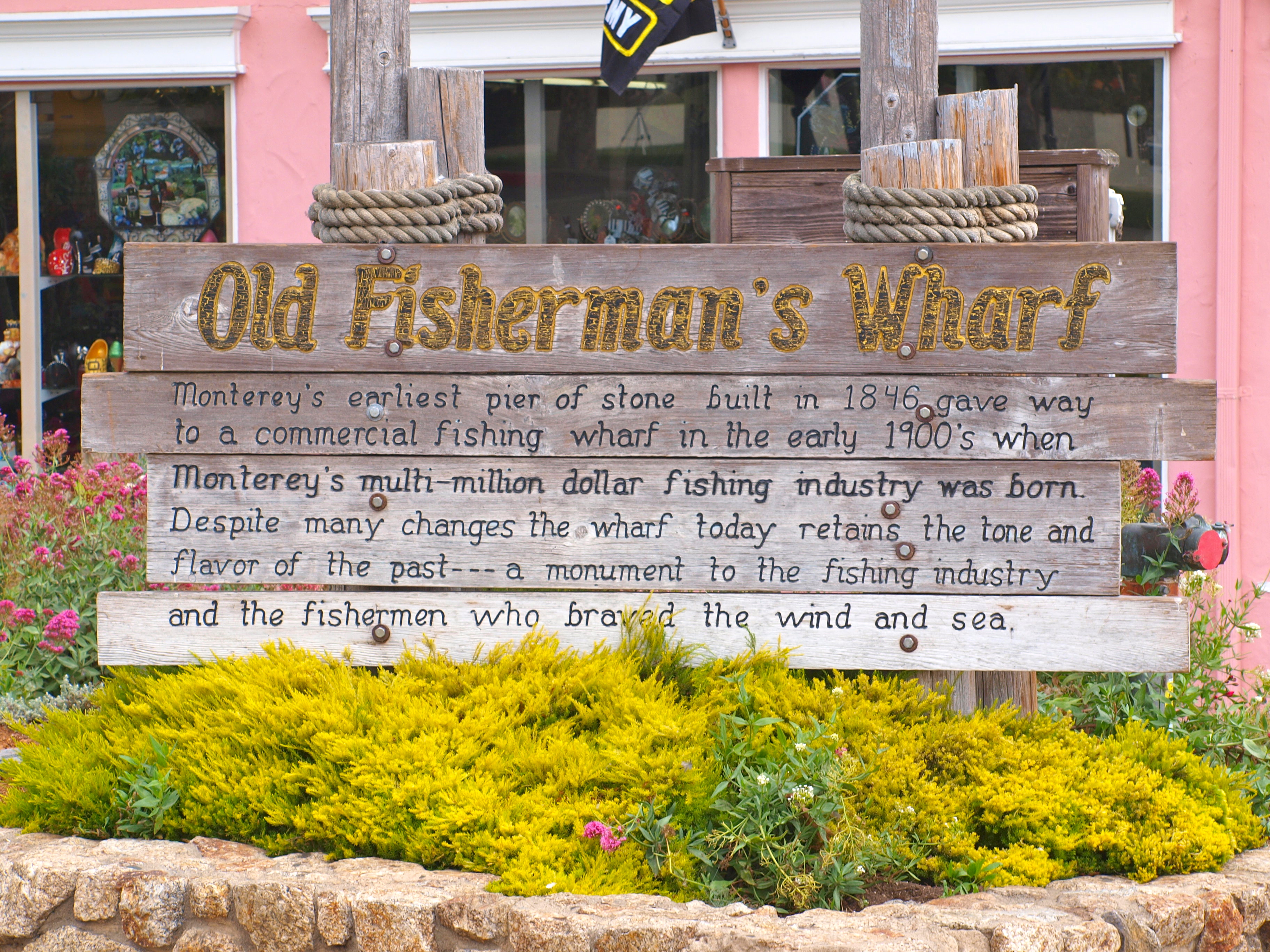
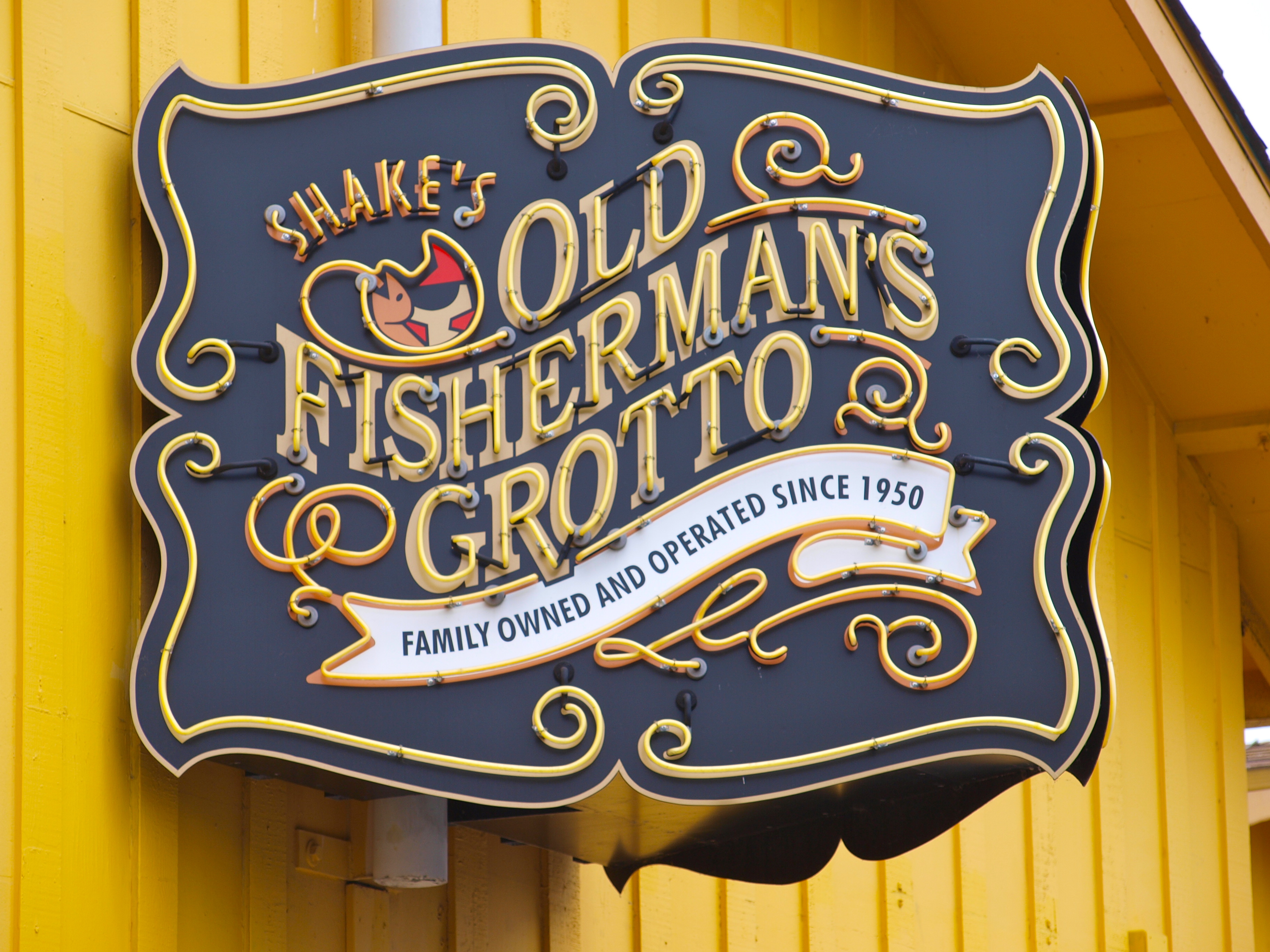
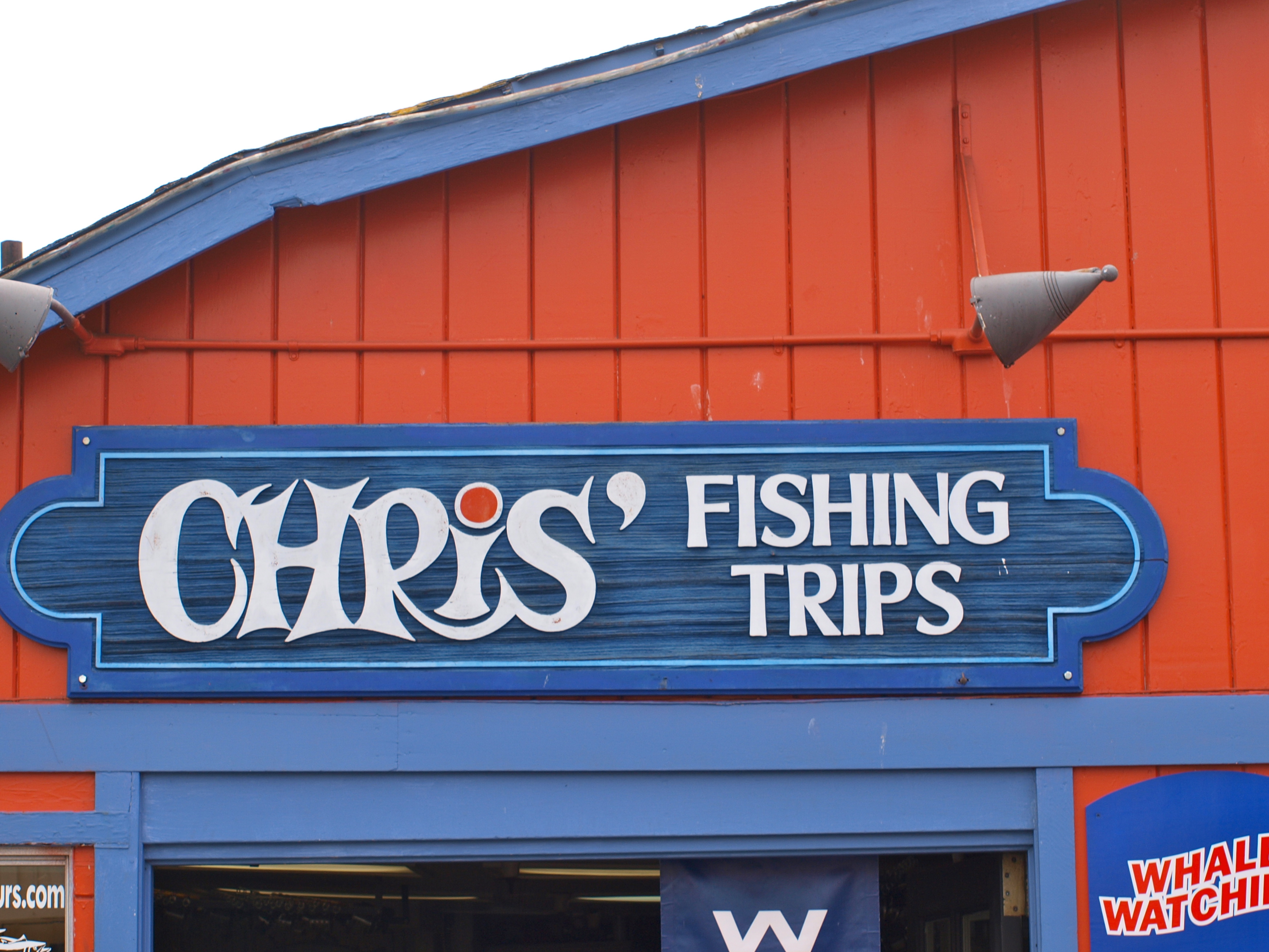
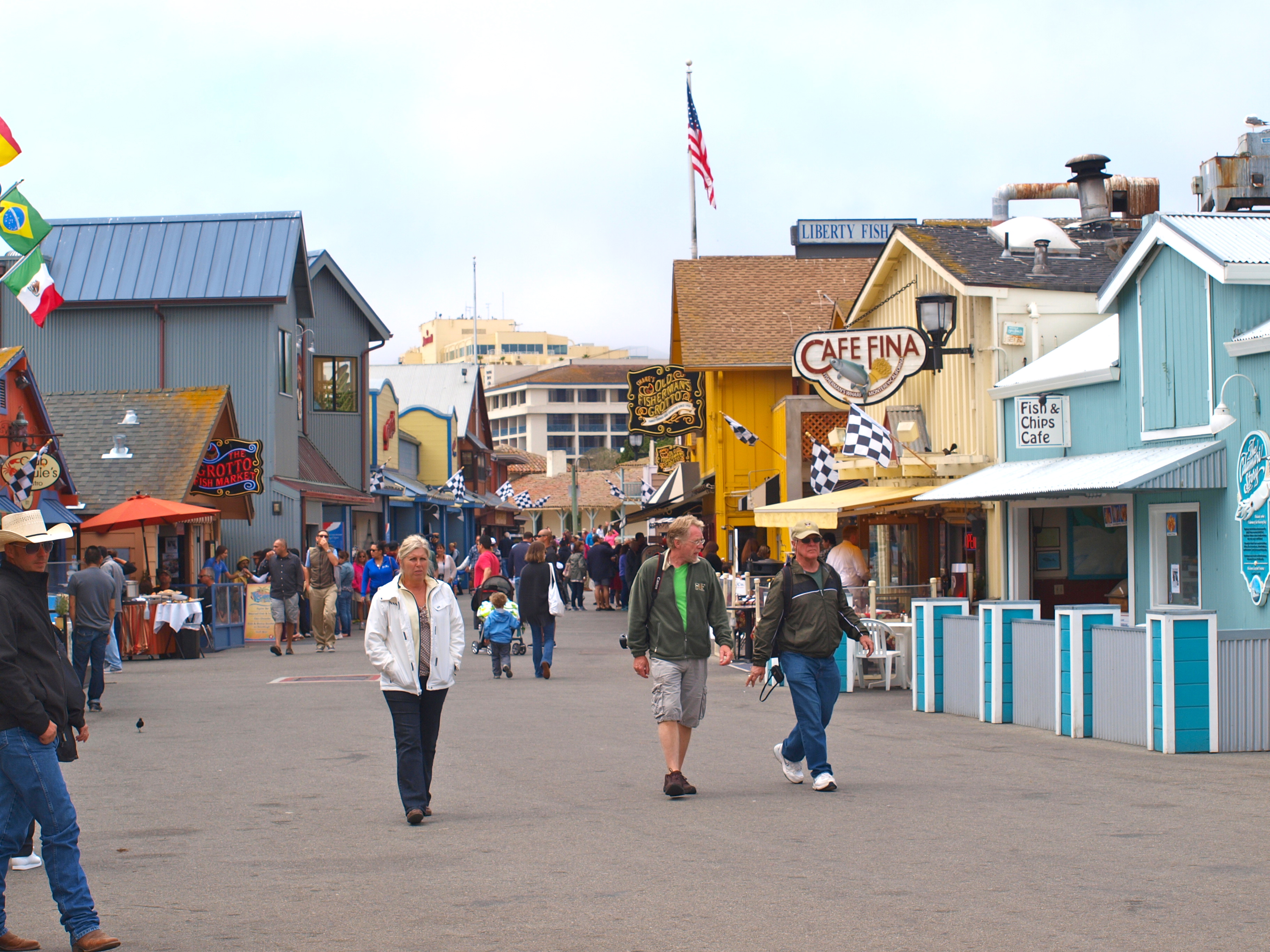
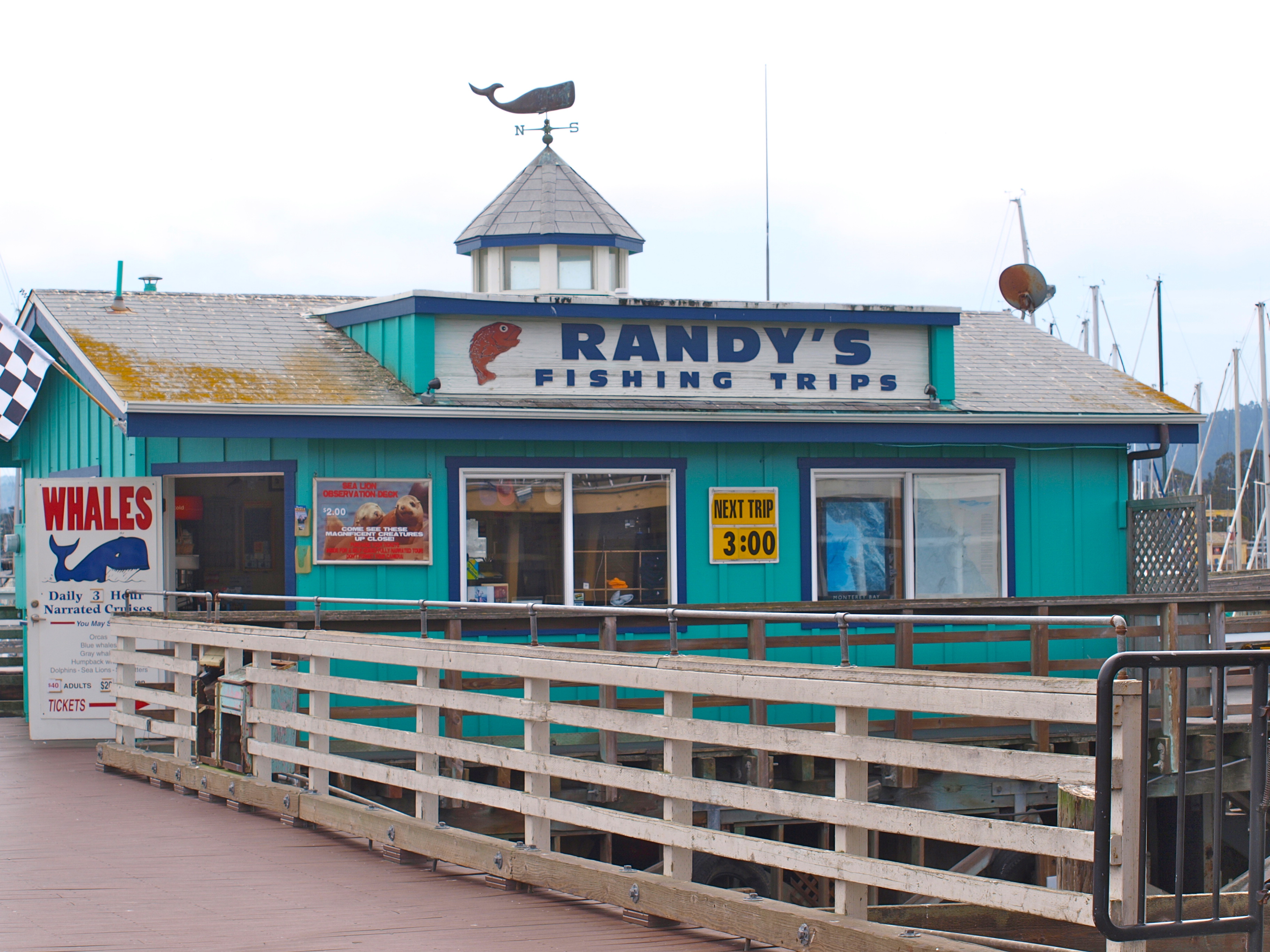
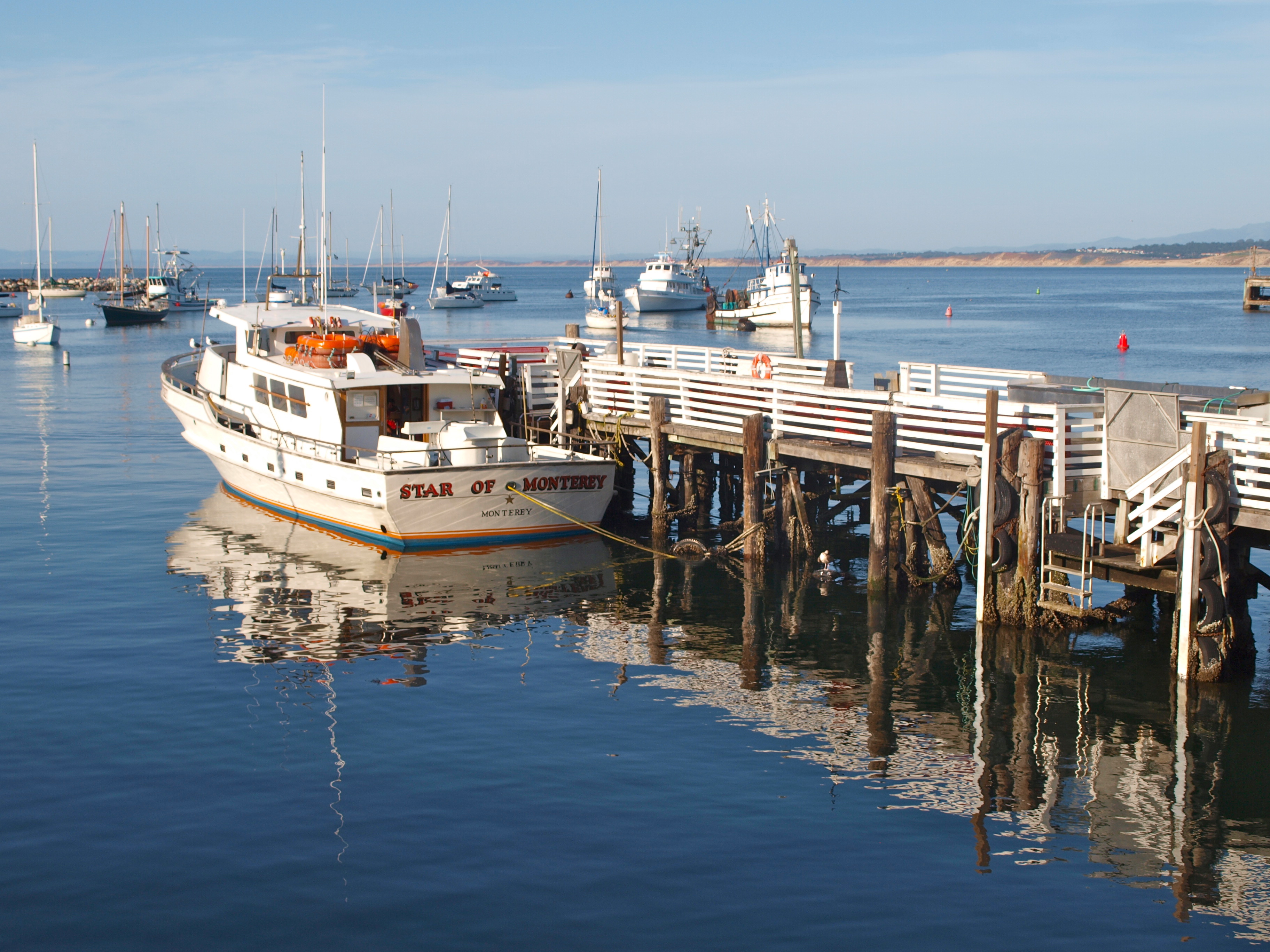
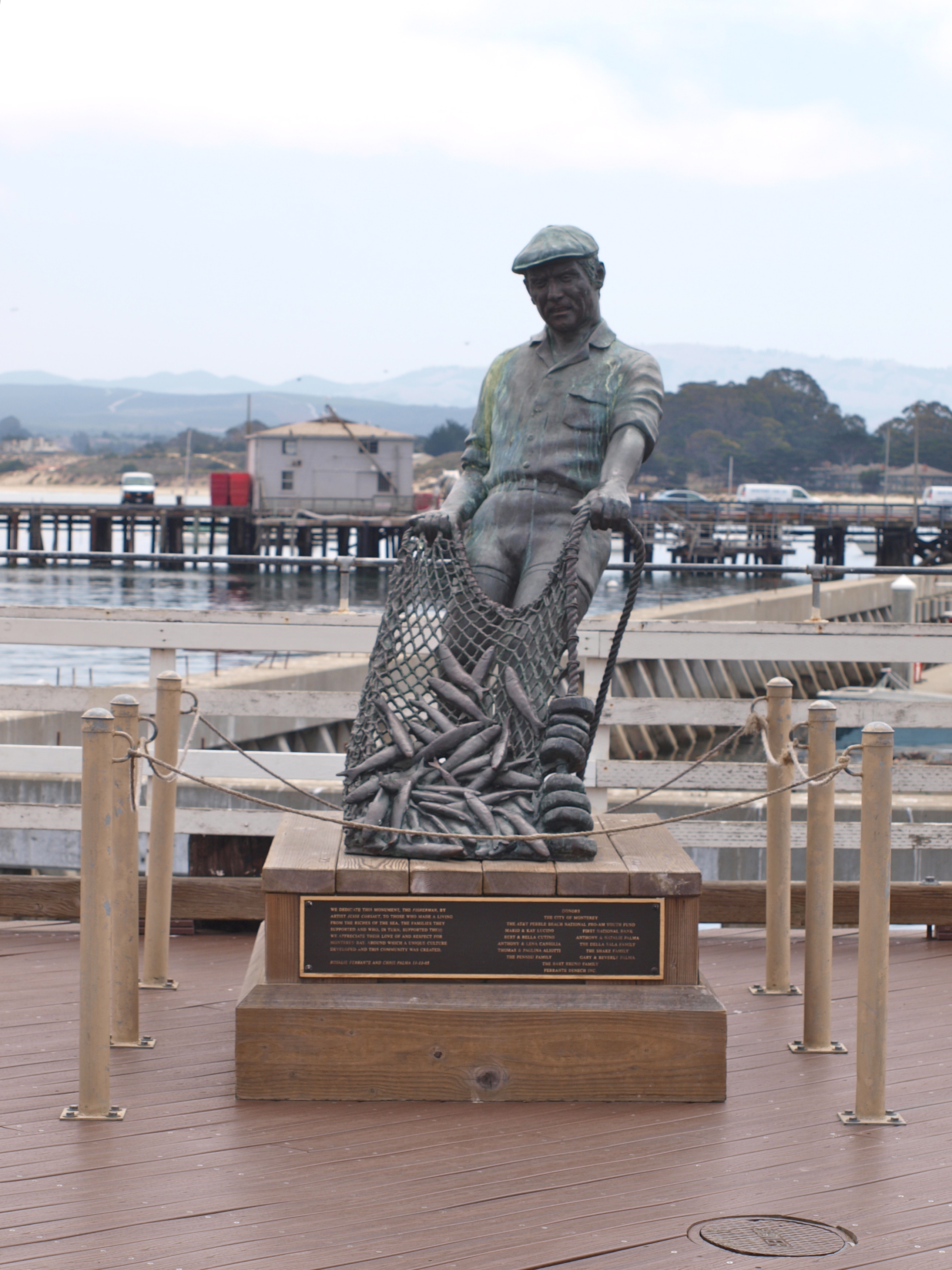
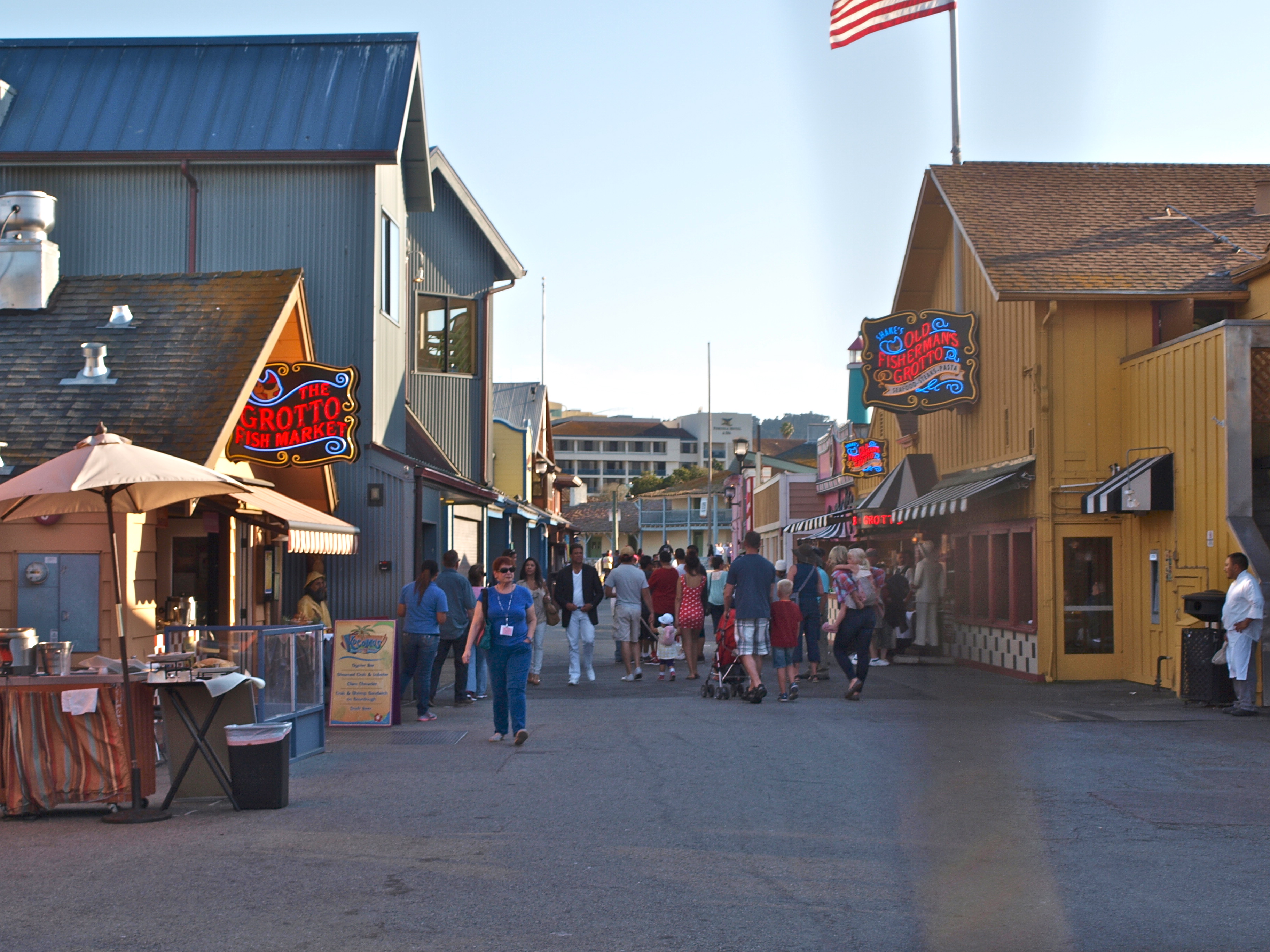
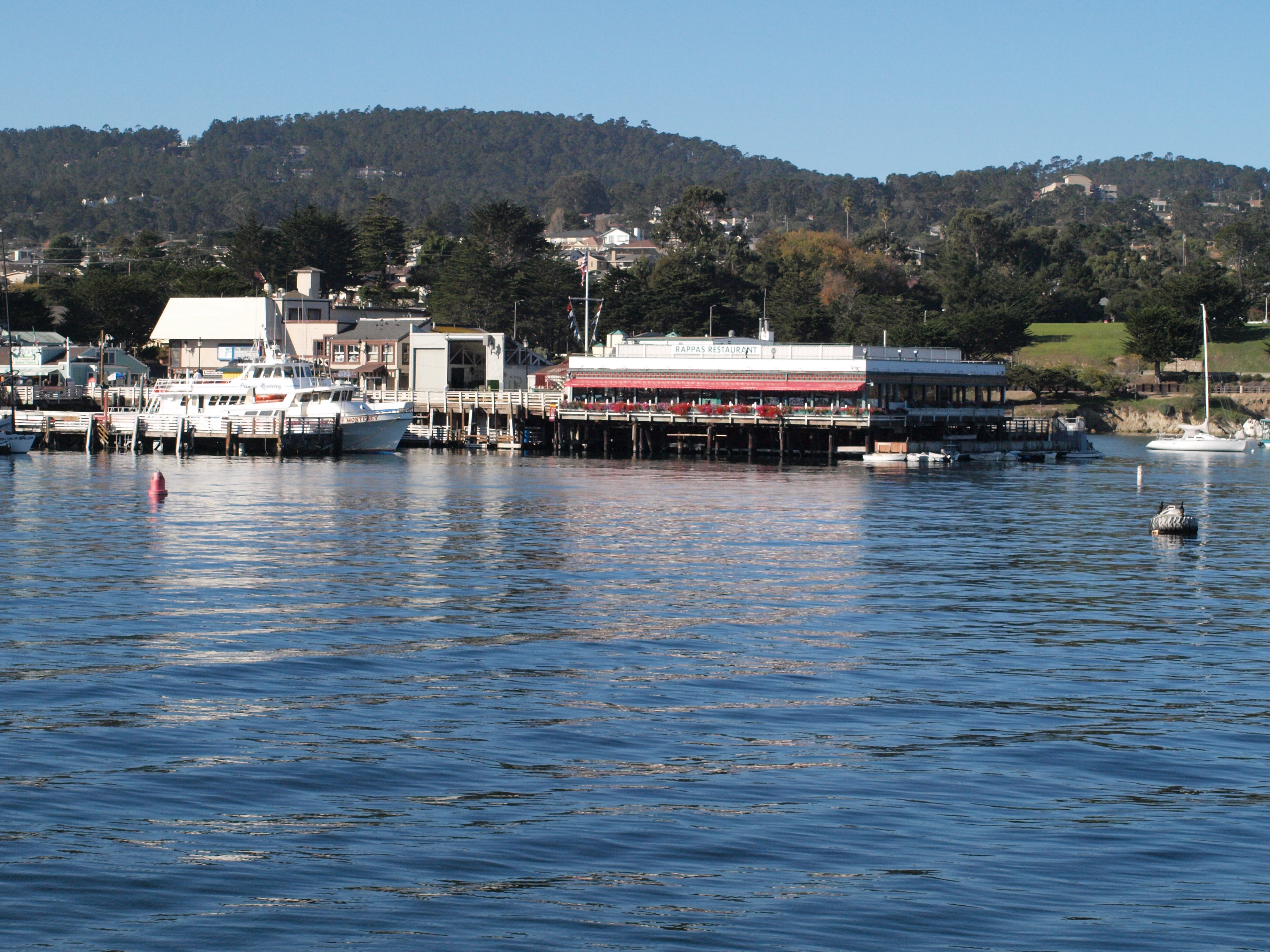
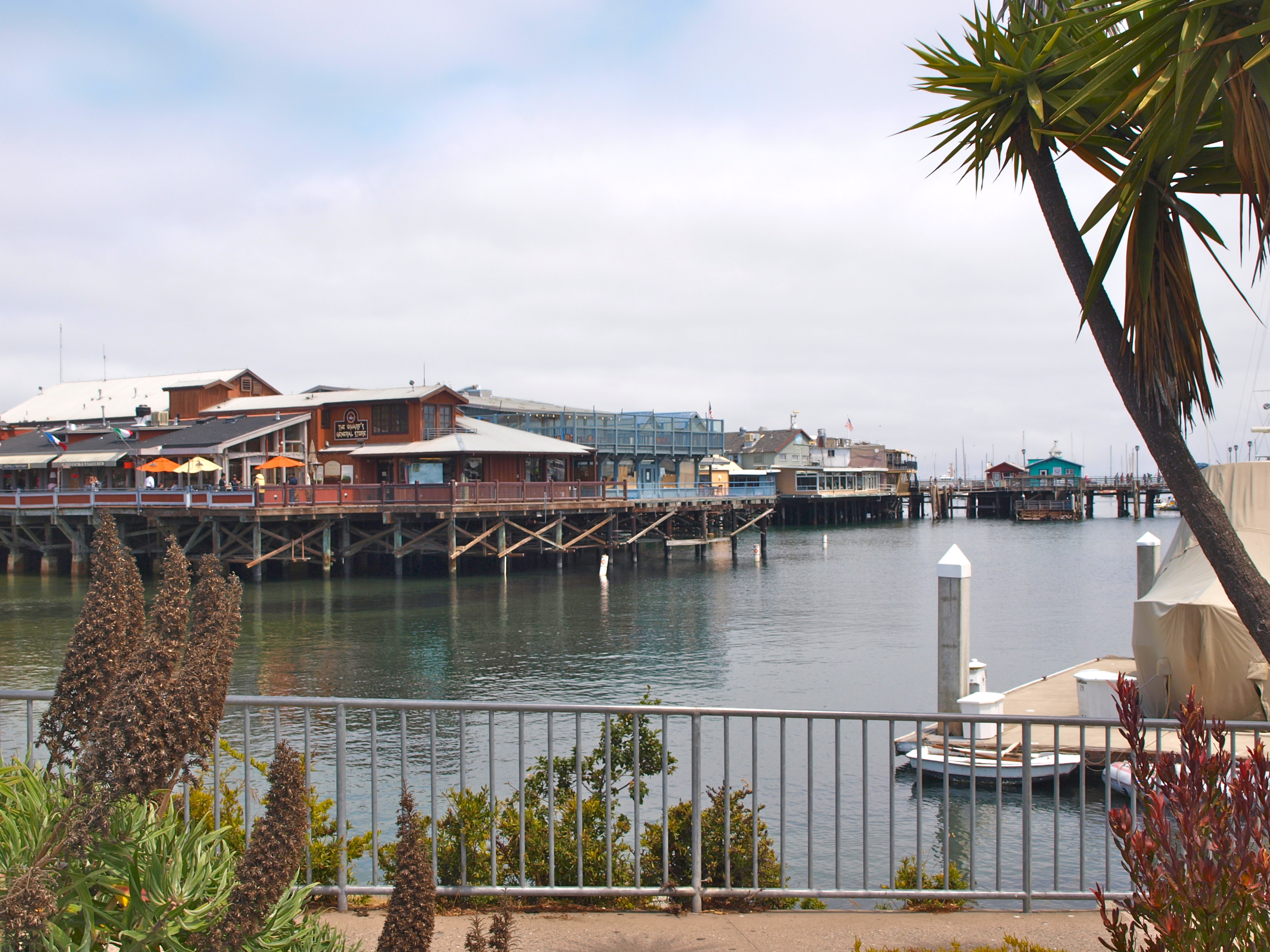
History Note. Monterey Bay was originally discovered by Cabrillo on November 16, 1542, and given the name Bahia de los Pinos. Cermeno crossed it on December 10, 1595, and called it San Pedro (in honor of Saint Peter Martyr, whose feast day is December 9). Seven years later, on December 16, 1602, Vizcaino anchored in what today is the harbor and named it Puerto de Monterey, in honor of Conde de Monterey, then viceroy of New Spain.
Over the years several different wharves and piers have graced Monterey’s coastline providing a means of transportation, as well as commercial and recreational opportunity. Today, the railroads and the wharves they used for transportation are gone. So too are the canneries with their round the clock activity and smells that made the area famous or perhaps more appropriately infamous. Commercial fishing boats still operate from Wharf #2 but the numbers seem to decrease each decade. Recreation though remains strong for the three types of local angling—recreational party boats, private boaters, and shore-bound anglers. Luckily there are still some fishing piers—but once there were even more.
___________________
California’s first oceanfront wharf, in fact its first wharf, was built in Monterey Bay in 1845 by Thomas Larkin. At the time, Monterey was still the Mexican capital of Alta California and most citizens agreed a wharf would be a useful improvement for the town. Larkin, one of Monterey’s leading businessmen, and one of California’s first entrepreneurs, decided to build the wharf. The wharf was built under contract with the Mexican administrator of the customhouse and though Larkin eventually asked the Mexican government to repay the $8,200 cost of building the wharf, he never received the money. Larkin would later serve as the first and only United States consul to California.
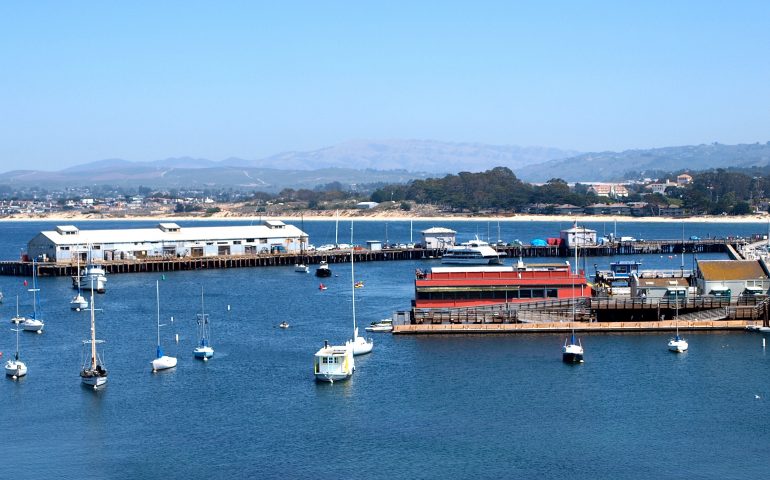
[…] The floating docks of Monterey Harbor and the pilings beneath Municipal Wharf II provide a rich and diverse community created largely by human activity. via […]